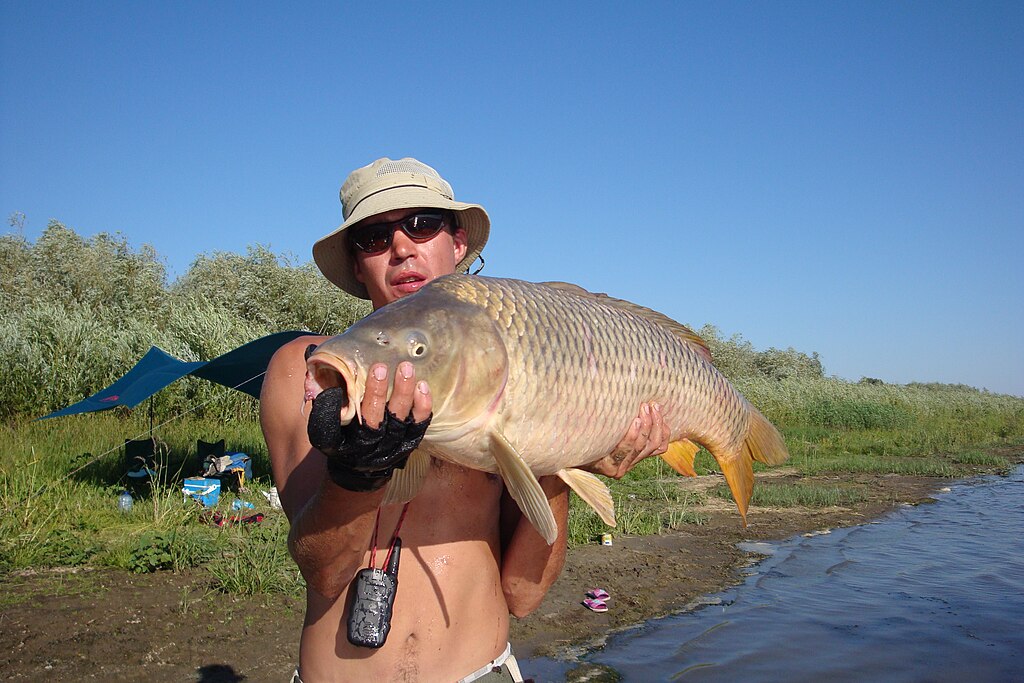
Common Carp
Scientific Name: Cyprinus carpio
Also known as: European Carp, German Carp, Mirror Carp, Leather Carp, Wild Carp
General Description
The Common Carp is a large freshwater fish species native to Europe and Asia but has become widely distributed across the globe. Known for its robust body and hardy nature, the Common Carp is a popular species for anglers and commercial fishermen alike. It features a thick, muscular build with a slightly flattened body and a large head. Carp are typically brownish or golden in color, with a long dorsal fin and barbels (whisker-like sensory organs) on either side of its upper jaw. They can grow to impressive sizes, with some individuals reaching over 30 pounds or more.
Carp are bottom feeders, known for their ability to thrive in a wide range of habitats, from slow-moving rivers and lakes to ponds and reservoirs. They are omnivorous, feeding on plant material, small invertebrates, and detritus, which makes them an interesting challenge for anglers using various bait types. They are also quite strong, putting up a formidable fight once hooked, making them a favorite target for sport fishing, especially in countries like the U.S. and the U.K.
Where to Find Them
Common Carp are highly adaptable and can be found in a variety of aquatic environments. They thrive in warm, slow-moving waters such as lakes, ponds, reservoirs, and lowland rivers. While they prefer deeper, muddy or silty areas where they can forage for food along the bottom, they are also known to inhabit areas with submerged structures such as weed beds, rocks, and sandbars. Carp are particularly common in areas with stable water conditions and abundant food sources, including in urban and suburban areas where they may have been introduced.
Carp are often found in shallow water during the warmer months, especially near the shorelines, where they feed on plant matter and small organisms. They are also present in deeper waters during colder months, especially in larger lakes and reservoirs. Though they are widespread across the U.S. and other parts of the world, they are particularly abundant in the Midwest and East Coast of the U.S., where they have been stocked in various bodies of water for recreational fishing.
Best Baits
Live Bait Options
- Worms (nightcrawlers, red wigglers)
- Minnows (shiners, fathead minnows)
- Crayfish
- Snails
- Small fish (live or cut pieces)
Artificial Bait Options
- Boilies (highly popular in European carp fishing)
- Doughballs (corn-based or bread-based)
- Carp-specific pellets
- Soft plastics (worms, grubs)
- Pop-up baits (floating or dough-like substances)
Best Fishing Methods
Fishing for Common Carp requires patience and some unique strategies, as carp are known for being elusive, especially when not actively feeding. One of the most popular techniques for catching carp is bottom fishing, where anglers cast baited hooks to the lake or riverbed, often using large sinkers to ensure the bait remains in place. Carp are particularly attracted to foods like corn, doughballs, and boilies, so these baits are often used when fishing for them. For best results, baiting the area ahead of time, a method known as chumming, can increase the chances of attracting carp to the spot.
Another effective method for carp fishing is float fishing. A float or bobber is used to suspend the bait at a specific depth in the water column. This method is especially useful in lakes and ponds where carp often feed closer to the surface. Carp fishing rods and specialized reels are often employed to handle the size and strength of the fish, with longer rods providing better casting distance and hook-setting capabilities. Anglers may also use bait runners or carp fishing alarms to signal when a carp has taken the bait.
Though carp can be caught year-round, they are most active in the warmer months, particularly during spring and summer. Carp fishing is often done early in the morning or late in the evening when the fish are most likely to be feeding.
Summary
Fishing for Common Carp is a rewarding and challenging pursuit, especially for those who enjoy a battle with a large, powerful fish. These bottom feeders require anglers to be patient, as carp can be elusive and picky eaters. However, once a carp strikes, anglers will enjoy a powerful fight, often pulling the fish to the surface with a strong, steady drag.
Carp are found in a wide range of habitats, from shallow ponds to deep reservoirs, and can be caught using a variety of baits, from live worms to specially crafted boilies. Bottom fishing and float fishing are the most popular methods, with anglers often using specialized equipment to handle the size of these fish. Carp fishing can be done year-round, with spring and summer being the peak seasons due to the fish’s increased feeding activity.
For anglers looking for a fun challenge and the opportunity to catch a large fish, the Common Carp is a fantastic option. Its hard-fighting nature and wide distribution make it a favorite among both novice and experienced anglers alike. Whether you’re fishing in a quiet lake or a bustling river, targeting carp is an enjoyable and rewarding experience.


